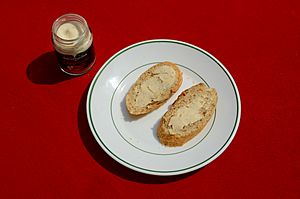Ricotta forte facts for kids
Quick facts for kids Ricotta forte |
|
|---|---|
 |
|
| Other names | ricotta 'scante, scanta, ascuante, squant (from the Latin ustulo which means to burn due to its taste) |
| Country of origin | Italy |
| Region | Basilicata, Apulia |
| Source of milk | Lua error in Module:Wikidata at line 70: attempt to index field 'wikibase' (a nil value). |
| Texture | Soft |
| Certification | Italy: PAT Prodotto agroalimentare tradizionale |
Ricotta forte is a special kind of soft cheese from southern Italy. It comes from the regions of Basilicata and Apulia. This cheese is known for being creamy, spicy, and a little bit bitter. Its name, "forte," means "strong" in Italian, which describes its powerful taste!
Contents
What is Ricotta Forte?
Ricotta forte is not like regular ricotta cheese. It has a much stronger flavor. People in Basilicata and Apulia have been making this cheese for a very long time. It is a traditional food that is important to their culture.
How is Ricotta Forte Made?
Making Ricotta forte is a unique process. It starts with milk, just like other cheeses. But then, special bacteria and yeasts are added to the milk. These tiny living things help the milk ferment, which means it changes over time.
This fermentation process gives Ricotta forte its spicy taste and very strong smell. The smell is often compared to a cheese called pecorino, which is also aged for a long time. A Greek cheese called kopanisti is made in a similar way.
How Do People Eat It?
Ricotta forte is a very versatile cheese, meaning it can be used in many ways.
- With Pasta: Many people use it to make tomato sauce for pasta taste even better. The strong flavor of the cheese adds a lot to the sauce.
- On Bread: It's also delicious spread on bread. Sometimes, people add anchovies (small salty fish) on top for an extra kick.
- In Panzerotti: In Italy, it's used in traditional fried pastries called panzerotti. These are like small calzones, often filled with cheese and tomato.
Official Recognition
Ricotta forte is so special that it has been officially recognized by the Ministry of Agricultural, Food and Forestry Policies in Italy. This means it is listed as a "Traditional Agri-food Product" (PAT). This recognition helps protect the way it is made and ensures it stays a part of Italian food traditions.

